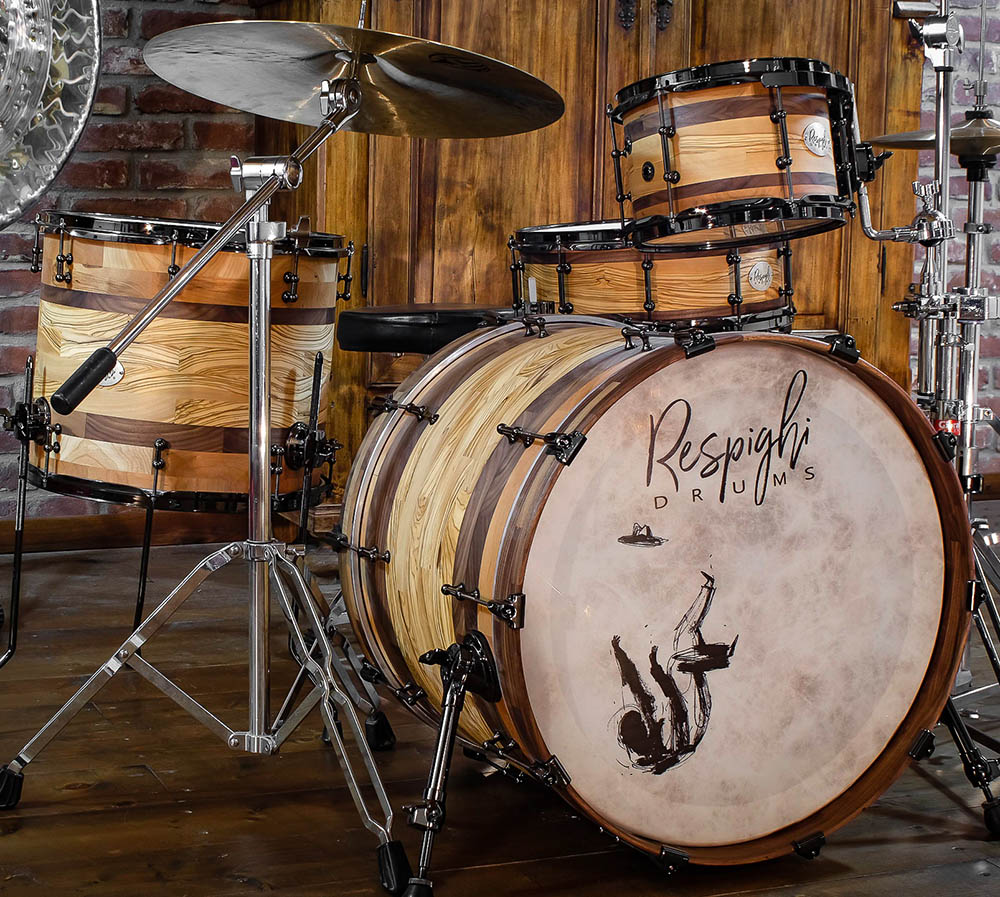Segmented Drums:
an against the grain choice.
The segmented method used to build the shells for Respighi’s handmade drum sets is rare among drum makers, who tend to opt for vertical staves. In other words, they build shells much in the way a barrel might be made.
The segmented method is well-known, and offers a wealth of advantages. So why is it used so little? Quite simply because it takes longer and is more complicated.
The process itself is more complex. Each stave has to be prepared manually, which is why industrial drum makers exclude it a priori, if only due the cost. It’s not commonly used by handmade drum makers either.
However, there are many advantages and they make the difference. Once the staves have been carefully prepared and shaped, they are glued together to form rings. These rings are then glued to each other. There are no joints so reinforcement rings aren’t necessary, because thankfully there’s nothing to reinforce! Most of all, there is no tension of any kind in the shell.

Why it is important to avoid tension in the shell.
A drum shell is a body that needs to vibrate freely. The easiest way to understand how this works and why it’s so important is to think of a guitar string: as the string gets tighter, the frequency of the sound it makes increases and the note becomes higher. However, when it comes to drums, the best sound is the result of a good blend of low frequencies. It’s what gives a drum full-body. While it’s relatively easy to make the medium and medium-high frequencies vibrate, especially as metal components no doubt help to do this, it’s more complicated to keep the low-frequency vibrations. Therefore, to make good-sounding drums, a drum maker needs to make sure that low frequencies resonate and to eliminate tension in the shell. That is basically the way to go.
The segmented method keeps tension to a minimum. This doesn’t happen with the vertical staves used in the so-called “barrel” method. After all, barrels are made so that they can be rolled horizontally. There is also a method using a number of layers called plies. This creates unwanted tension because of the way the wood moves due to changes in humidity and the gluing process itself.
Oddly enough, even a hollowed out shell doesn’t work. While a drum made from a single piece of wood might be captivating, there are still risks: how is it possible to foresee how the wood will move? What torsions and tensions will be created once it is hollowed out? It’s no coincidence that those who use this technique, for example to make clarinets, do so over very long periods of time: They hollow out a bit, then wait and let the wood season. They make sure it’s all right and then continue. This process can take as long as 12 years, and we’re talking about a small, 5 centimeter shell.
A drum maker needs to make sure that low frequencies resonate and has to eliminate tension in the shell.
The only truly valid construction technique other than the segmented method involves making the shell from one board of solid wood, which is heat-molded and then glued. In this way, the grain is constant throughout the shell. In addition, heat-molding results in considerable stability. Craviotto, a famous American maker of high-quality drum sets uses this approach.
Wood: some myths to debunk
As can easily be seen by browsing the Gallery, Respighi’s handmade drum sets love wood: they almost always show it in all its beauty. They try to enhance its grain and design, experiment with colors, and put different types of wood together.
There’s a reason for this choice. There is a tendency to believe that certain types of wood produce a certain sound, and above all that some wood is not suitable for drum sets. Actually, if you experiment and listen carefully, you realize that’s really not necessarily true: different woods might play differently, but that doesn’t mean they have to sound bad. What changes is the subtlety of tone, not the quality. A lot of woods that are conventionally considered inappropriate for drum sets can actually produce outstanding results if chosen and worked carefully.
When making a shell from two or more types of wood, the tendency is almost always to combine woods with different characteristics. Typically, a “soft” wood with a “hard” one: padauk and maple, or walnut and poplar for example.
The reason for this has already been mentioned: the search for a roundness of response at all frequencies.
This is one reason why the inside of the shell isn’t sanded down like the outside. The variations in thickness of the staves are left irregular; sometimes there is as much as a couple of millimeters difference. Just as the way the equal temperament of the piano aims to make the entire keyboard play harmoniously, the research into Respighi drums’ shells aims to prevent certain frequencies from drowning out others.
A lot of woods that are conventionally considered inappropriate for drum sets can actually produce outstanding results if chosen and worked carefully.
Finishes
Solid wood is a noble material, so it goes without saying that the vast majority of Respighi drum sets tend to have finishes that exalt the beauty of the wood and its grain. This is the most natural and respectful choice. It’s also the most aesthetically pleasing one, as enhances the intrinsic qualities of the wood being used.
Over time, the finishes used have become increasingly varied: water, polyurethane, hard-wax oils, linseed oil, Shellac. Naturally, the finish can be matt, silk or glossy. This depends on the customer and on the wood. The thickness of the finish is always kept to a minimum.


